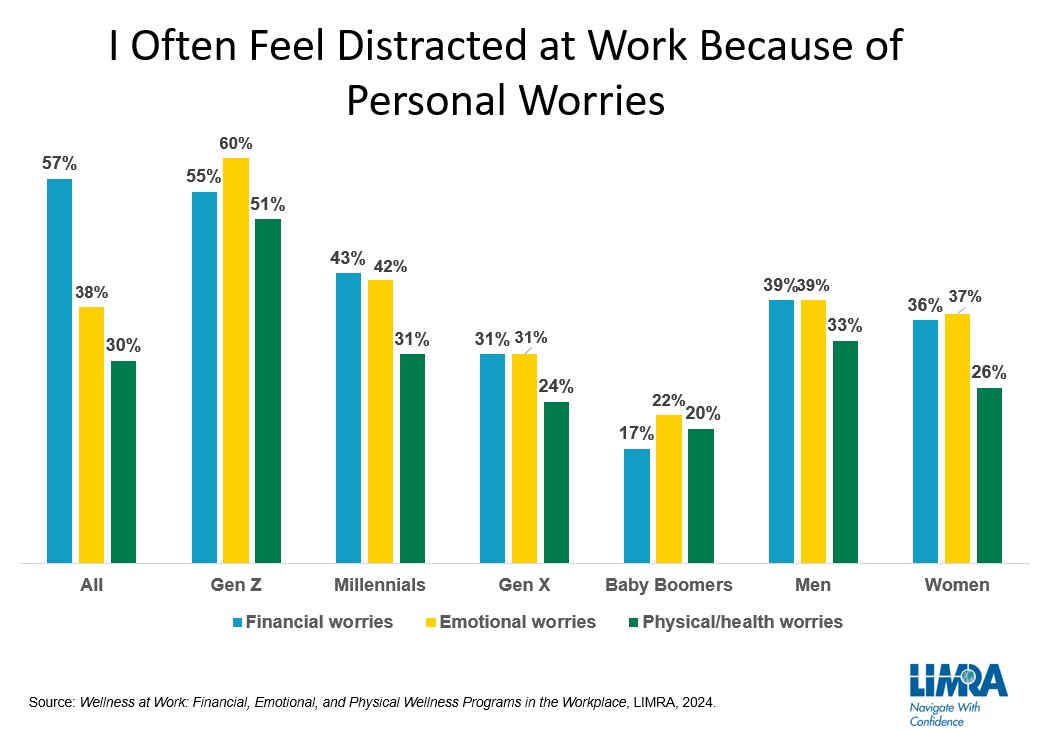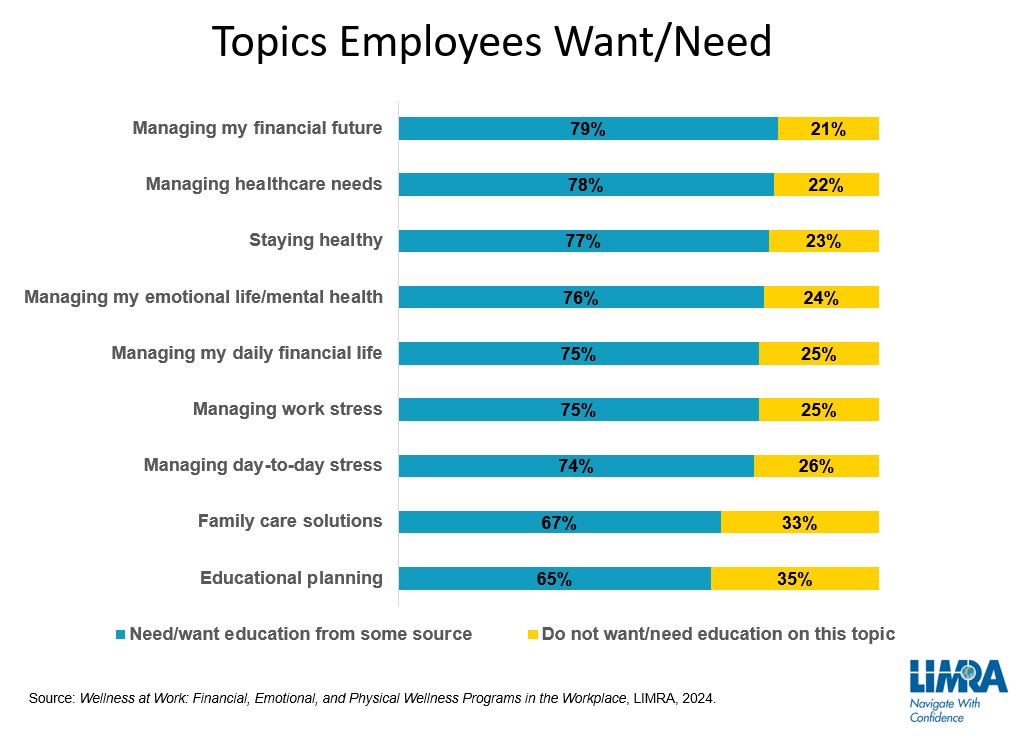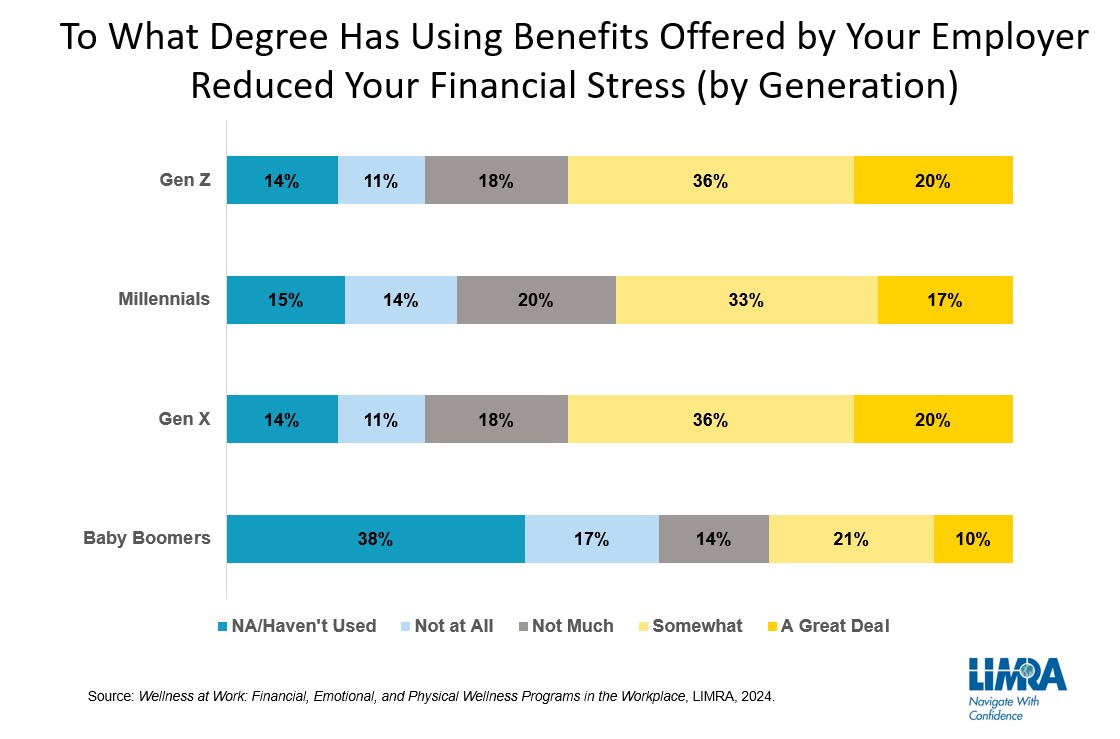Media Contacts
Catherine Theroux
Director, Public Relations
Work Phone: (860) 285-7787
Mobile Phone: (703) 447-3257
2/19/2025
Workers look to employers to provide wellness programs
Coming out of the pandemic, workers are feeling more stress with many facing education debt, rising inflation, housing shortages, and increased pricing on groceries and other consumer goods. LIMRA research, Wellness at Work: Financial, Emotional, and Physical Wellness Programs in the Workplace, shows that workers — particularly younger ones — are looking for employers to help with wellness programs, services, education and benefits.
LIMRA defines financial wellness as being confident in your financial situation, able to withstand unexpected expenses, and being able to plan for a financially secure future. Benefits that directly help with financial wellness include health insurance, a retirement plan, paid time off and wellness programs.
Implementing financial wellness programs that provide financial education, counseling and planning tools can help employees manage their finances more effectively. In recent years, wellness services have been growing. Newer benefits developed to meet these needs include emergency savings assistance, employee assistance programs and student loan assistance.
Wellness at work
Wellness programs can increase the efficacy of benefits. Workers who use a workplace wellness program — whether it’s financial, emotional or physical/health — report that their workplace benefits are significantly more effective in relieving stress than those who do not participate in such programs.
The most commonly offered wellness education features the management of work-life balance, while the most in-demand, but not available, are education about managing stress and health, nutrition, and work-life balance.
Eldercare, a growing concern for today’s workers, is the least available topic in the workplace … but 20% of workers say that they would use such education if it were available.

This is important for employers since wellness-related issues/worries are a significant workplace distraction for many workers. Nearly 4 in 10 workers report that personal worries are a distraction to them at work. Financial and emotional issues are a greater workplace distraction than physical/health-related issues.
The Need for Wellness Education
Most workers admit to needing or wanting education on a wide variety of wellness topics.

Retirement planning is the most common type of financial education available to workers through their employers; 55% of employees report that their employer does offer or sponsor this education, and 41% report that they use it.
There’s a great deal of opportunity for wellness programs in the workplace. LIMRA research suggests most workers would like to receive information/education from an employer, benefits provider, or other resource with an implied endorsement from their employers.
Most in-demand is education about estate planning, which is only available to 19% of employees, with nearly twice as many (34%) saying they would use it if offered by their employers.
About half of workers report that their employers do not offer a wellness program, and roughly a quarter of those workers report that they would use these programs if available.
Views on stress and wellness differ by generation and gender
Workplace wellness programs may be beneficial in attracting and retaining younger workers, who are more likely than their older counterparts to feel that employers should offer benefits that help with stress (financial, emotional, and physical) reduction.

Mid-career generations — Millennials and Gen X — are more stressed (than older or younger workers) by job/career situations and by maintaining work-life balance.
Baby Boomers — the oldest workers surveyed — are significantly less likely to use physical/health-related wellness programs. Women are more likely than men to report that they would use wellness support if offered at their employers, especially financial wellness.
Wellness programs — however they may be defined — are likely worth the employer effort. LIMRA research shows employee satisfaction with such programs is very high at 80% or more. These programs can improve worker productivity and also help with employee retention, making it a smart investment for employers.
Director, Public Relations
Work Phone: (860) 285-7787
Mobile Phone: (703) 447-3257